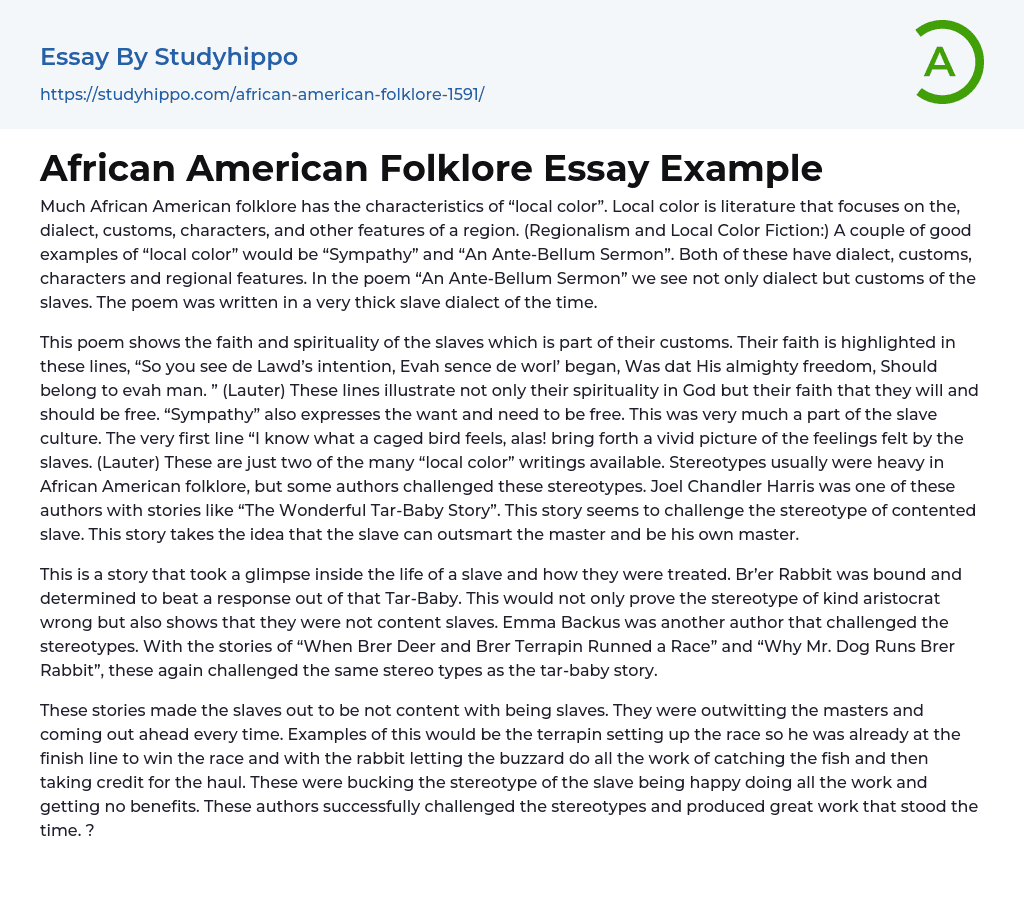Much African American folklore has the characteristics of “local color”. Local color is literature that focuses on the, dialect, customs, characters, and other features of a region. (Regionalism and Local Color Fiction:) A couple of good examples of “local color” would be “Sympathy” and “An Ante-Bellum Sermon”. Both of these have dialect, customs, characters and regional features. In the poem “An Ante-Bellum Sermon” we see not only dialect but customs of the slaves. The poem was written in a very thick slave dialect of the time.
This poem shows the faith and spirituality of the slaves which is part of their customs. Their faith is highlighted in these lines, “So you see de Lawd’s intention, Evah sence de worl’ began, Was dat His almighty freedom, Should belong to evah man. ” (Lauter) These li
...nes illustrate not only their spirituality in God but their faith that they will and should be free. “Sympathy” also expresses the want and need to be free. This was very much a part of the slave culture. The very first line “I know what a caged bird feels, alas! bring forth a vivid picture of the feelings felt by the slaves. (Lauter) These are just two of the many “local color” writings available. Stereotypes usually were heavy in African American folklore, but some authors challenged these stereotypes. Joel Chandler Harris was one of these authors with stories like “The Wonderful Tar-Baby Story”. This story seems to challenge the stereotype of contented slave. This story takes the idea that the slave can outsmart the master and be his own master.
This is a story that took a glimpse inside the life of a slav
and how they were treated. Br’er Rabbit was bound and determined to beat a response out of that Tar-Baby. This would not only prove the stereotype of kind aristocrat wrong but also shows that they were not content slaves. Emma Backus was another author that challenged the stereotypes. With the stories of “When Brer Deer and Brer Terrapin Runned a Race” and “Why Mr. Dog Runs Brer Rabbit”, these again challenged the same stereo types as the tar-baby story.
These stories made the slaves out to be not content with being slaves. They were outwitting the masters and coming out ahead every time. Examples of this would be the terrapin setting up the race so he was already at the finish line to win the race and with the rabbit letting the buzzard do all the work of catching the fish and then taking credit for the haul. These were bucking the stereotype of the slave being happy doing all the work and getting no benefits. These authors successfully challenged the stereotypes and produced great work that stood the time. ?
- Book Summary essays
- Metaphor essays
- Reader essays
- Rhyme essays
- Literary devices essays
- Villain essays
- Books essays
- Genre essays
- Literary Criticism essays
- Writer essays
- Protagonist essays
- Simile essays
- Poem essays
- Book Report essays
- Book Review essays
- Greek Mythology essays
- Plot essays
- Tragic Hero essays
- Coming of Age essays
- Play essays
- Rhetoric essays
- Rhetorical Question essays
- Translation essays
- Understanding essays
- Reason essays
- Character essays
- Letter essays
- American Literature essays
- Literature Review essays
- Utopia essays
- Poetry Analysis essays
- Dante's Inferno essays
- Between The World and Me essays
- Incidents in The Life of a Slave Girl essays
- Flowers for Algernon essays
- Myth essays
- Everyday Use essays
- Boo Radley essays
- Genesis essays
- Richard iii essays
- Alice in Wonderland essays
- On the road essays
- Ozymandias essays
- The Nightingale essays
- Holden Caulfield essays
- Animal Farm essays
- 1984 essays
- A Hanging essays
- Shooting An Elephant essays
- A Tale Of Two Cities essays




